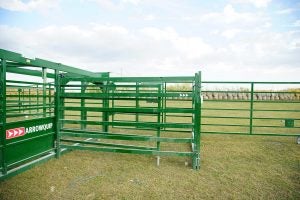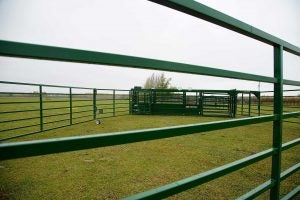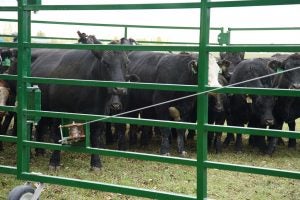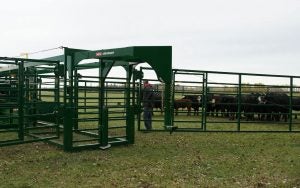Of the cattle handling industry innovations that have significantly improved the daily lives of ranchers and how they work cattle, portable corrals stand out. The added flexibility, adaptability, and ease of transport make them a must-have on any operation, especially those that have cattle in multiple pastures or remote locations away from the ranch and the main cattle handling system.
Every day, ranchers face many decisions. To ensure those decisions are in the best interest of your cattle, business, and ultimately your bottom line, it’s important to ask questions and take the time to research before coming to a final decision and parting with your hard-earned dollars.
When it comes to portable corrals, ranchers often have many questions about how to choose the best option for their operation. To help you with choosing your corral, here’s a guide to help answer three of the most asked questions.
Which portable cattle corral is best for my ranch?
Selecting the right portable cattle corral for your operation is a decision that you will either appreciate or regret every time you use your corral. Ensuring you choose a portable corral that is durable and able to be used and hauled on varying types of terrain to all your locations is key.
Most corrals are equipped with folding panels on airless tires to assist with set up and tear down, but in some cases, corrals can still be difficult to use. Aim to research or test out prospective corrals, when possible, to be sure they’re easy to use and don’t leave you exhausted before the real work has even begun.

While it is important that your portable corral works with your cattle’s instincts, it should also make getting the job done easier for you. User-friendly components, a straightforward setup, and being able to work throughout the corral safely and easily with well-placed gates and cattle-free zones are important factors to consider.
Using your portable corral for treating, sorting, and loading cattle, rather than using conventional methods such as roping cattle to treat them in the pasture, or using wooden, stationary systems, increases your efficiency and safety while also decreasing the stress level of your cattle.
When considering purchasing any new cattle equipment, it is also important to ensure you do business with a company that stands behind its products with customer service and warranty programs. Should an issue ever arise, or you require replacement parts, will you be able to get assistance, or be left high and dry?
Where should I place my portable cattle corral?
Knowing how to evaluate sites and what works best will make the job easier the first time you set up the corral, and every time you take it to a new location. Where you choose to place your portable cattle corral is the foundation of how you will work cattle, and there are a few key factors to consider.
Most important, think about accessibility. If you can get to the location without any major issues, and a truck and trailer can easily turn around, you’re sure to have a more pleasant and efficient working experience.

Think about the size of your chosen location and how far you and your cattle will need to travel to reach the corral. Is the distance realistic given the day-to-day demands of your operation and the equipment you’ll have on hand? Ideally, you will set up near the location’s entrance, so you don’t have to haul cattle over rough terrain for an unnecessary amount of time if you’re loading them out or worry about getting hung up on a drainage ditch or deep ruts.
Existing structures and natural landmarks can also dictate where you place your corral. If you choose to set up your portable corral along a fence line, it can help you guide cattle by pushing them forward along the fence and into the corral. Be sure you also consider any nearby water sources, trees, shelters, and structures before setting up your corral.
How many cattle can I work in my portable cattle corral?
Perhaps the most common question of all, how many cattle can be worked in your corral. This will vary depending on the portable corral you choose to purchase, but there is a simple equation you can keep in mind when selecting a corral to be sure your investment will remain useful for your operation for years to come.

First, start with your herd size and the approximate number of cattle you will need to work at one time. A common rule of thumb for holding pens is to have 20-square feet for each cow and 14-square feet for each calf. If you are working pairs, they each need 34-square feet.
Once you have this number, you can select a portable corral that meets your square footage requirements. Keep in mind the varying number of cattle you may have at separate locations. If you have 100 cow-calf pairs in one pasture and 75 in another, you may think you require a portable corral with more square footage, but larger corrals are not always more efficient.
When working fewer cattle in a corral with large pens, managing them becomes difficult as they can get easily get past handlers. To avoid this, aim to choose a corral that allows you to bring along extra panels to increase the capacity of the pens, and look for a portable corral that offers a bud box or multiple pens to make sorting cattle easier.

A well-thought-out portable cattle corral allows you to safely and easily work cattle, while maintaining optimal flow and efficiency. Spending time asking questions, doing research, and noting options that make the most sense for the needs of your operation, will ensure your experience with your new corral is positive, and that you won’t end up with buyer’s remorse.
Start the search for your portable cattle corral by researching Arrowquip’s Heeler Portable Corral, a cutting-edge system built for simple setup and optimal cattle flow. Visit arrowquip.com or contact their team at 1-866-383-7827 for details.
This article was published on behalf of Arrowquip.


